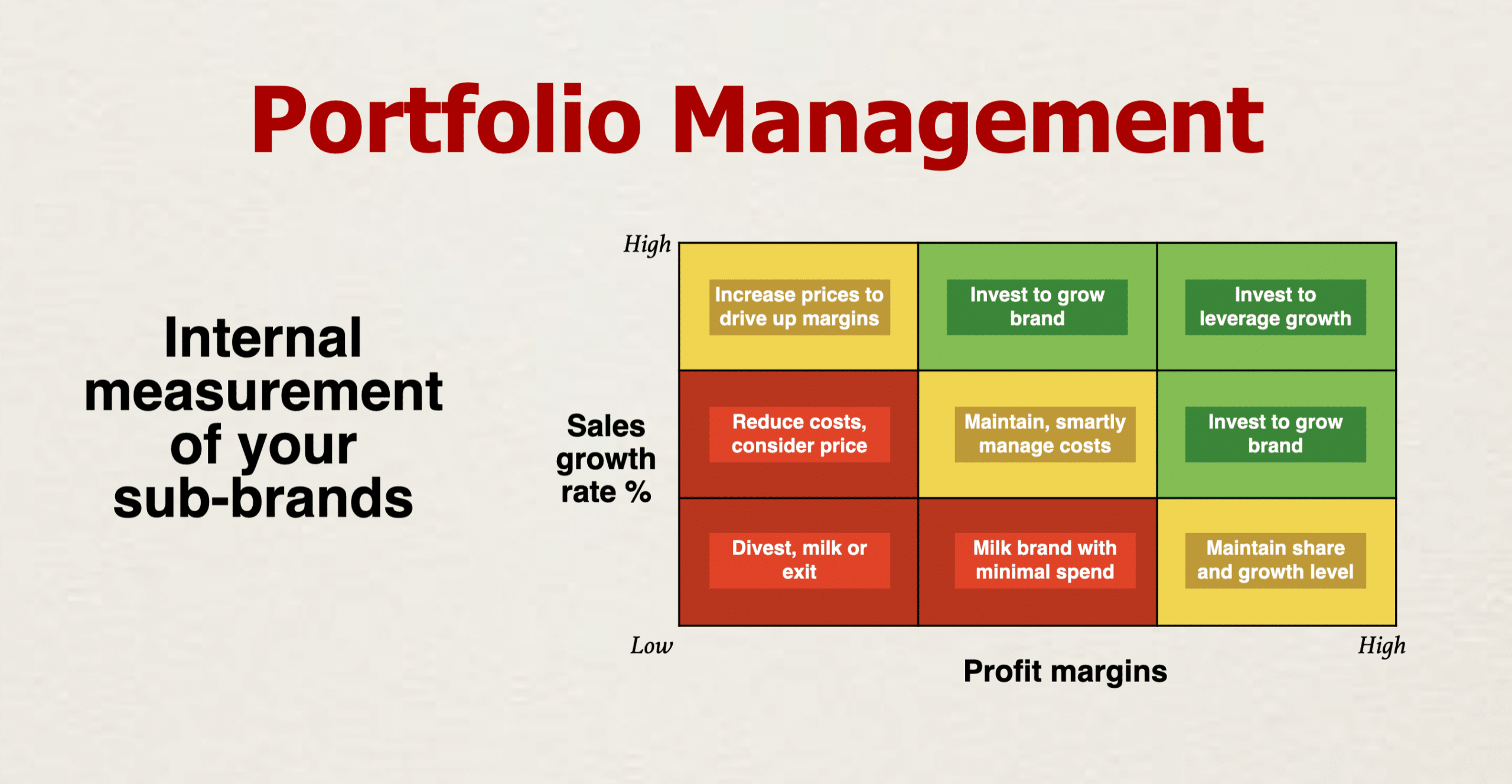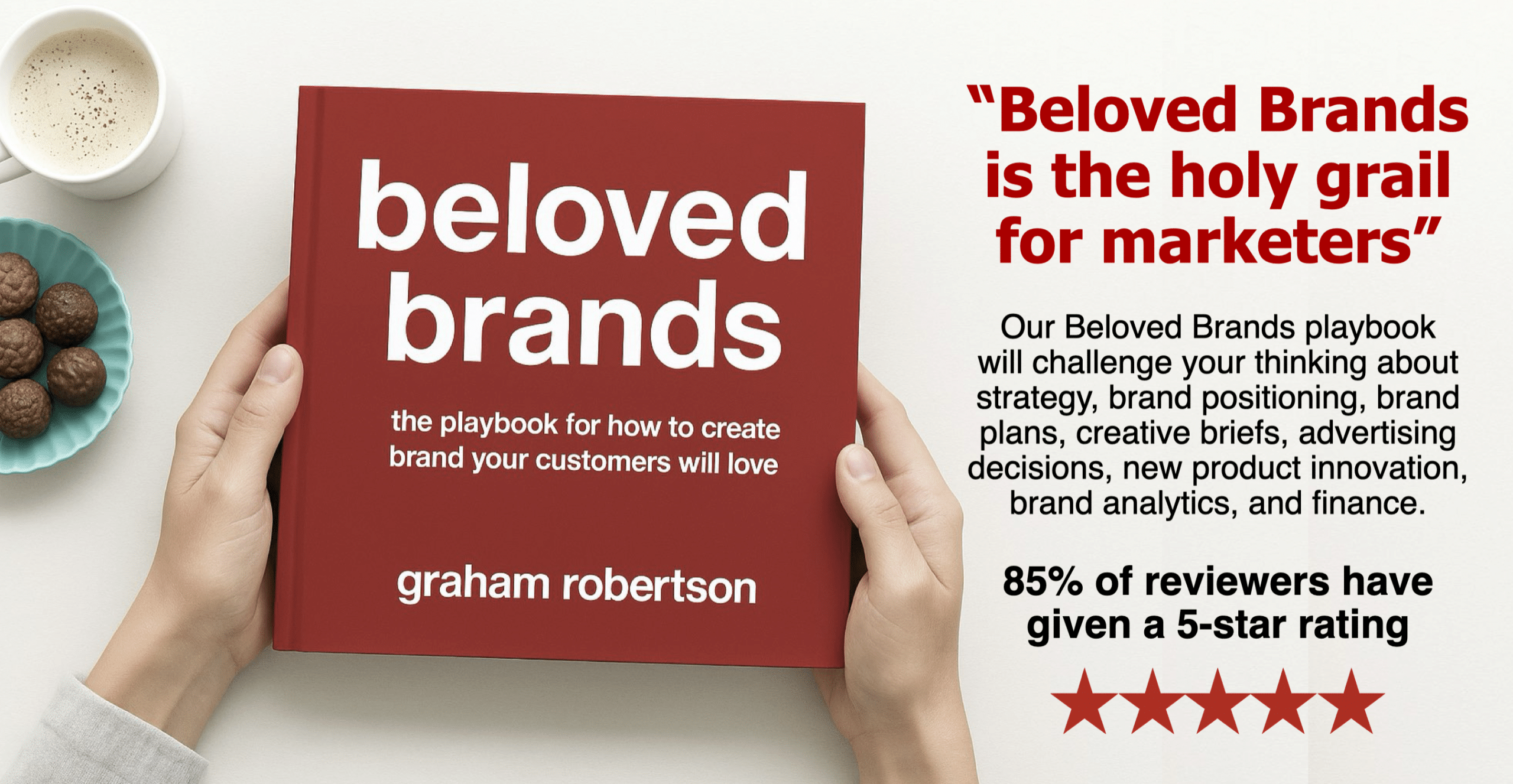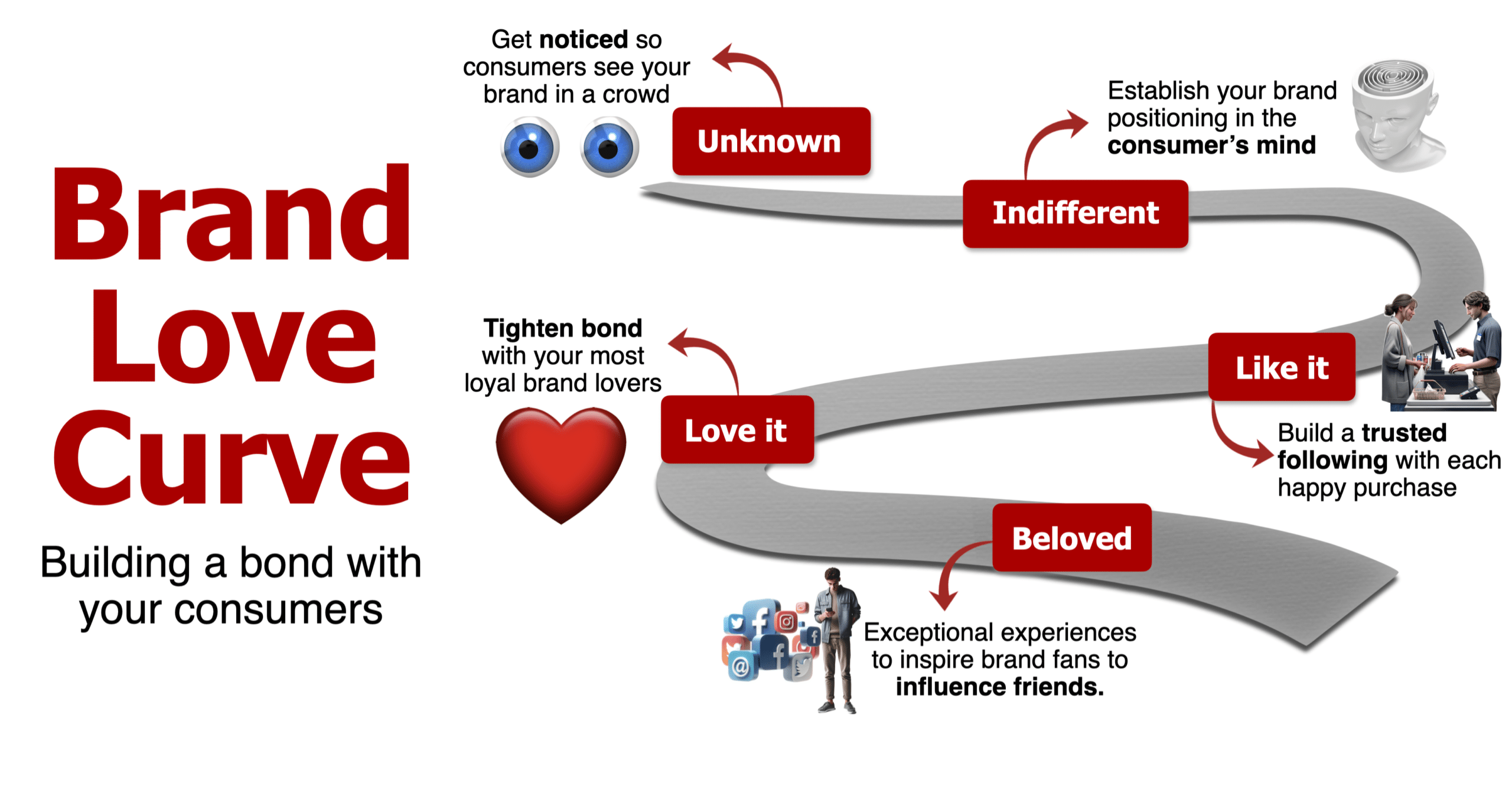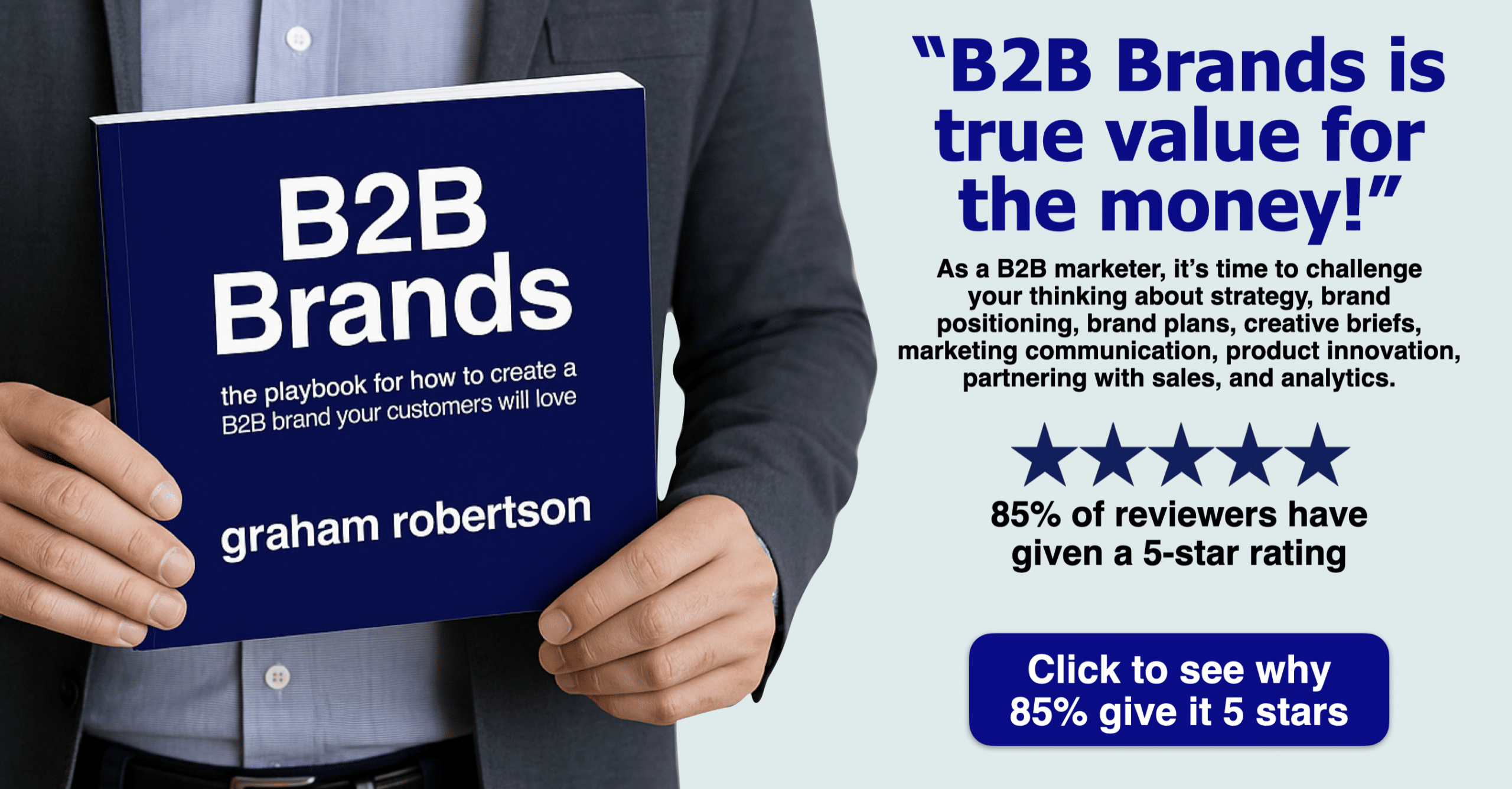Portfolio Management is an investment strategy to deliver maximum payback for the company using a collection of brands. A portfolio of brands requires a diverse set of investments. Each brand needs to be carefully selected to meet specific goals. Marketers must allocate their budget to achieve the desired goals across the portfolio requires an external and internal view.
Start your portfolio management with an external lens. Look at the market attractiveness of where the brands play and the competitive position of those brands within the market. Then match up to the internal lens. Look at the growth rate of each brand and the profit margins of the brands.
The portfolio management decisions directly impact the investment levels of each brand and affect the performance of each brand. For the leader, your decisions end up self-fulfilling as those brands you choose not to invest in will not perform. Be comfortable knowing that your decisions allows more resources to be put to what you determine will be the winners.
Portfolio of brands
Portfolio management looks at the outside and inside measures of your brands
Brands within a portfolio usually share common traits, such as product categories or target markets. They also often share the same go-to-market approaches.
Portfolio management should be built around the investment of financial and people resources. The specific management of each brand to achieve the best performance, the collective power of the total portfolio, and the fit of each brand within the portfolio. A brand’s major investments are in advertising, innovation, sales coverage, and the customer experience.
Manage each brand to its full potential
If you’ve developed a brand that has resonated with your target audience, it can be tempting to adopt an “if it ain’t broke, don’t fix it” mentality and expand your operations. However, this isn’t always the best strategy. It’s important to consider how well the new brands will fit alongside the ones you already have in your portfolio before you take the leap.
Building a successful business takes a lot of work and careful consideration. It also requires time and money. CMOs often find themselves torn between their different ideas for new ventures they want to pursue at one time because they are all worthy of investment. They need to prioritize which ones will most likely bring them success.
What is brand portfolio management
Portfolio management: Start with the external view
In terms of portfolio management, use our grid (below) that looks at two factors; market potential and the competitive position of your brand.
In terms of market attractiveness, you can look at the size of the market and growth rate, plus market dynamics. Consider consumer trends, loyalty among consumers, influencer opinions, competitive dynamics, new technology, and the role of channels.
When it comes to the competitive position, start with the overall market share. But you can also look at the competitiveness of your brand. Even if you play in a niche, your competitive position is much stronger if the brand is well-protected.
Our portfolio management grid sets up 9 different types of investments
To illustrate, click on diagram to zoom in to see details.
High investment: High market attractiveness / highly competitive
In the grid above, we look at those brands that fall into the green zone. These brands are in highly attractive markets with the most elevated competitive position.
These brands are where you put your best people, invest in advertising and R&D for new innovation. You need to manage the power of your brand with channel customers, media, and the consumers who love the brand. Use a high investment level when your brand faces many investment factors. These include a profitable brand, reliable messaging, product innovation, and an intensely competitive situation. You can afford to take a mass approach.
However, just because you have a lot of money does not mean you should waste it. I still recommend using one lead media choice and then use support media to supplement. Figure out your lead paid media and your lead earned media to provide focus and alignment with your strategy.
Moderate investment levels
Those brands that fall into the yellow part of the grid would be the moderate investment levels for those in highly attractive markets with the highest competitive position.
If you are a highly competitive brand in an unattractive market, leverage your brand power more than the investment. Those that fall in the middle of the grid would see a maintenance investment level.
With a medium investment level a selective media plan. Make smart choices of the target market who you know will respond to those media choices proven to pay back.
Lower investment levels
When your brand is smaller but still in an attractive market, you want to own a niche with a craft brand strategy.
Craft brands must win a small space in the marketplace that offers something unique to a highly engaged target. These brands succeed when they are far enough away from major competitors. You need the leaders to ignore you so you stay hidden away.
Craft brands build themselves behind a micro-benefit, including gluten-free, low fat, locally grown, organic, or ethically sourced. These craft brands take an antagonistic approach to the rest of the category. They portray other brands as old-school, overly corporate, unethical, flawed in the manufacturing, or the use of ingredients. These brands often take a very aggressive marketing stance, calling out the other brands as unethical or stupid. Craft brands believe it is better to be loved by the few than liked or tolerated by many.
To illustrate, click on diagram to zoom in to see details.
It would be wise to start with a smaller investment level. Use what I call a “blowfish” media plan so that, among those you target, you appear to be a large brand. Pick a tight target market with a limited media choice or geographic focus to replicate how a more substantial media investment would appear.
Brands that fall into the red zone should bring a reduced investment to divest, milk, or exit. Another option is to sell these brands to a company that would value them more than you can.
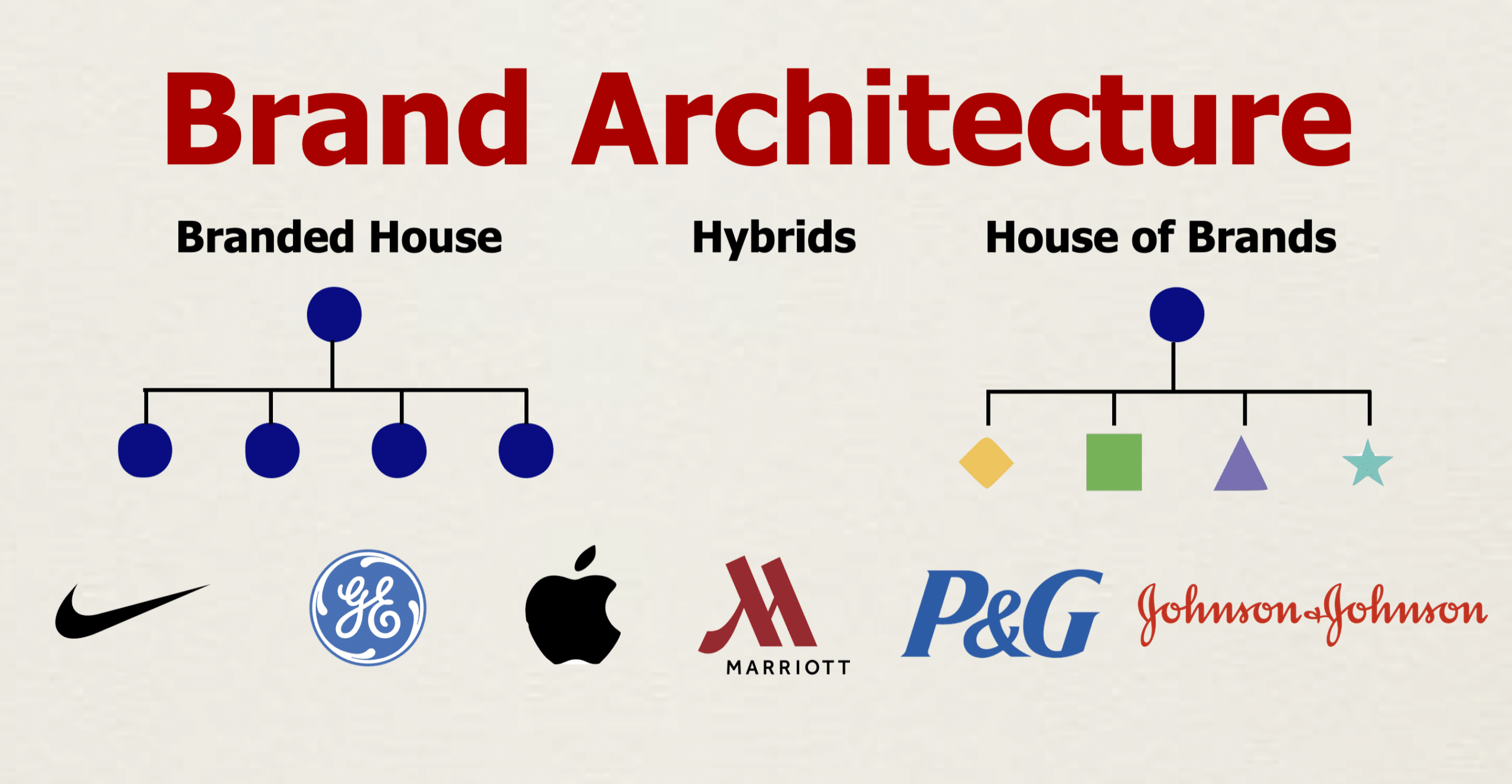
Understanding the types of brand architecture
The first step in mastering brand architecture is to understand the different types of brand architecture. Here are some of the most common types:
Branded House:
Also known as a monolithic brand architecture, this type of architecture features a single master brand that represents all the company’s products and services. Examples of branded house architecture include Apple and Nike.
House of Brands:
Also known as a freestanding brand architecture, this type of architecture features multiple independent brands that are not associated with the parent company. Examples of house of brands architecture include Procter & Gamble and Nestle.
Endorsed Brands:
This type of architecture features multiple brands that are endorsed by a parent brand. The parent brand provides credibility and support to the endorsed brands, but the endorsed brands still have their own identities. Examples of endorsed brands architecture include Marriott and Mastercard.
Sub-Brands:
This type of architecture features multiple brands that are associated with a parent brand. The sub-brands may have their own identities, but they are still part of the parent brand. Examples of sub-brands architecture include Microsoft and Chevrolet.
By understanding the different types of brand architecture, you can choose the one that works best for your business and helps you achieve your goals.
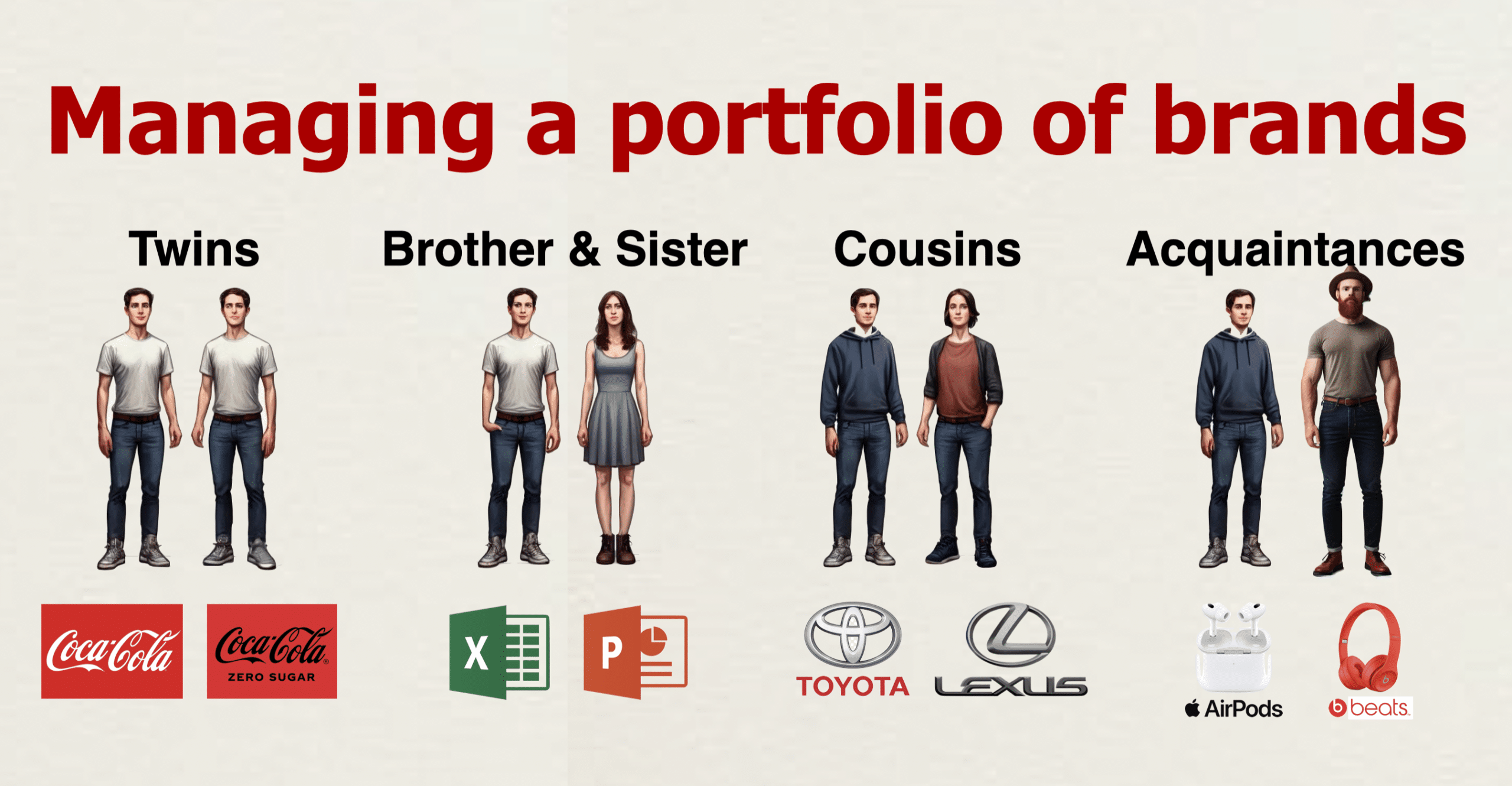
Portfolio Management
We simplify the thinking around portfolio management by considering whether specific sub-brands should be considered twins, brother and sister, cousins, or acquaintances. This is a conceptual way to consider how many shared elements sub-brands should have.
Twins
Product extensions can end up nearly identical in look and feel as they serve the same target with similar benefits. For example, Coca-Cola and Coca-Cola Zero Sugar. As we’ve seen over the last 10 years, Coke has been all over the place with Coke Zero. Is it a brand itself? They finally said no, “We have sugar and non-sugar versions of the original Coke.”
Brother & Sister
Sub-brands can share the same look, feel, and brand idea but stretch the target by offering different benefits. While they have tried to create ‘distinct’ brands, the reality is that these should all be part of the same family. For example, Microsoft Excel and PowerPoint act as brother and sister.
Cousins
Brands share some look and feel elements but focus on a different target with different benefits or price points. For example, Toyota and Lexus are cousins. We know they share ownership but are distinct in price point and target. They do a better job than Acura, which seems like an expensive Honda, or Infiniti, which has zero mental connection to Nissan.
Acquaintance
Brands in the same category but with a different brand name, look & feel, target, price point, and benefits. Synergies and associations help both. For example, Apple AirPods and Beats Headphones. Apple owns both and they are found in the same store. However, they have let the Beats brand continue to own its unique space. Despite previous rumors about discontinuing the Beats brand, Apple has successfully leveraged Beats to target a broader user base, including Android smartphone owners, which has further fuelled its growth.
Understanding these relationships can help your overall brand strategy, making it easier to manage multiple products under one umbrella. Next time you look at a sub-brand, you can use this simple tool as a starting point. Is it a twin, brother/sister, cousin, or acquaintance?
Brand Management
How loved is your brand?
I first came up with the idea of a brand love curve when I ran a marketing department with 15 different consumer brands, which exhibited various degrees of success. Honestly, it was hard for me to keep track of where each brand stood. I did not want to apply a one-size-fits-all strategy to brands with dramatically different needs. I could have used some traditional matrix with market share versus category growth rates or stuck with revenue size versus margin rates. Every day on the job, I noticed brands that had created a stronger bond with their consumer outperformed brands that lacked such a close connection. I started to refer to the high-performance brands as “beloved” because I could see how emotionally engaged consumers were with the brand.
At the other end of the scale, I referred to the inferior performance brands as “indifferent” because consumers did not care about them. They failed to stand for anything in the consumer’s mind; they were not better, different, or cheaper. I could see how these brands were unable to create any connection with their consumers and they faced massive declines.
Everything seemed to work better and easier for beloved brands.
New product launches were more impactful because the brand’s loyal consumers were automatically curious about what was new. Retailers gave these the beloved brands preferential treatment because they knew their consumers wanted them. With a beloved brand, retailers knew their consumers would switch stores before they switch brands. Everyone in my organization, from the President to the technician in the lab, cared more about these beloved brands. No one seemed to care about the indifferent brands. Internal brainstorm sessions produced inspiring ideas on beloved brands, yet people would not even show up for brainstorms on indifferent brands.
Our agencies bragged about the work they did on beloved brands. Even my people were more excited to work on these beloved brands, believing a move to the beloved brand was a big career move while being moved to an indifferent brand was a career death sentence.
These beloved brands had better performance results and better consumer tracking scores on advertising. They saw a stronger return on marketing investment, with a better response to marketing programs, higher growth rates, and higher margins. The overall profitability fuelled further investment into beloved brands.
Why does brand love matter?
Brand building starts with cultivating close relationships with consumers. The best brands of today follow a very similar path to the rituals of a personal courtship.
Through the eyes of consumers, brands start as complete strangers, randomly purchased a few times without much thought. They become acquaintances and, when the brand successfully delivers on expectations, they move into something similar to a trusted friendship.
As the consumer sees a consistent experience and trust, they begin to open up, and the romance begins.
The consumer allows their emotions to take over and, without knowing, they start to love the brand. As the brand weaves itself into the best moments of the consumer’s life, the consumer becomes an outspoken fan, an advocate, and one of the many brand lovers who cherish their relationship with the brand. As long as the brand delivers on the excitement of the original promise that attracted the consumer on their first encounter, the brand moves into a position where the consumer sees it as a forever love.
To replicate how brand building matches up with the building of a relationship, I created the brand love curve, which outlines how consumers move through five stages: unknown, indifferent, like it, love it, and onto the beloved brand status.
For new brands, they were completely “unknown” to consumers. Unless there were genuinely compelling messages, consumers would walk past without even looking. To achieve some success, the priority for these brands is to get noticed within the clutter of the market.
At the “indifferent” stage, consumers feel O.K. about the brand, similar to how they usually feel about commodities, like fruit and vegetables.
These brands satisfy the consumer’s basic needs. Consumers will only buy the brand when it is on sale, but switch back to their other brand choice when it is not. Make your brand more than just a commodity. Brands need to be better, different, or cheaper. Otherwise, they will not be around for long, and you waste your investment.
Brands that reach the “like it” stage experience the first sign of business success. Their consumers see the brand as a logical, functional, and smart choice. However, the lack of any emotional connection leaves the purchase up to chance. Consumers will still switch brands randomly. Brands at the like it stage stress the product performance so much they forget to trigger any emotions.
Brands at the “love it” stage start to see more emotionally engaged consumers.
The rule of love you must follow: Consumers must love the brand before you can tell consumers you love them. Consumers see the brand as a favorite choice, usually connected to a favorite part of their day. They are loyal and build the brand into a routine. These brands must also find a way to demonstrate their love toward consumers and continue to tighten the bond with their most loyal brand lovers.
The “beloved brand” stage is where the brand becomes iconic, with a core base of brand lovers who cherish and defend the brand. These consumers see the brand as a personal choice, a badge they proudly hold in their hand or wear on their feet. At the beloved stage, the brands must create magical experiences that inspire brand lovers to share with their friends.
Media Planning
What is the size of your brand’s media budget?
Balance the media choices by looking at media efficiency, quality, impact, and fit with the brand. The efficiency of media math starts with reach and frequency.
- Reach is the number or percentage of different households or people exposed to the ad at least once, over a specific period.
- Frequency is the number of times that household or person will be exposed to the ad within a particular period. Be careful to avoid relying on efficiency alone, as you need to balance it with the quality of the media choices.
I always set aside about 10 percent of my media budget to create a high impact to generate early attention to a new campaign or product innovation.
Use your strategic thinking to understand how much you can invest. You need to focus your limited resources on a distinct opportunity point you have identified based on a potential change in the market.
The reasons you would strategically invest in media include:
- Discovery of a new brand message you know will motivate consumers to buy your brand.
- Identified change in consumer needs, motivations, or behaviors, which will benefit your brand.
- Shift the competitive dynamic, with an opportunity to make gains or a necessity to defend.
- Continue to fuel brand growth with a window to drive brand profits.
- New distribution channel you can use to move consumers through before competitors do.
- The launch of a breakthrough product innovation offering a competitive advantage to your brand.
To make the media investment pay off, you need to be able to drive a performance result that pays back with an increase in brand power you can use in the future or an immediate increase in brand profit.
Six factors to guide you on the size of your media investment of the brands within your portfolio:
- Brand profit situation, looking at margin rates and the size of the business.
- Past media ROI projected forward as a forecast of the potential.
- Impact of your current creative advertising tracking results
- Future investment opportunities or future threats to battle.
- The degree of competitive pressures in the marketplace and their levels of media spend.
- The comparative opportunity cost for investing elsewhere. This is where portfolio management looks at the tradeoffs.


